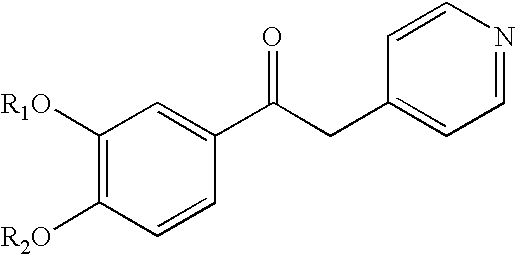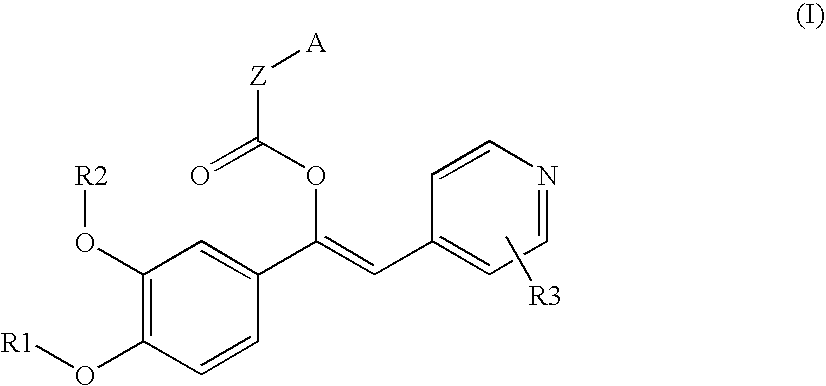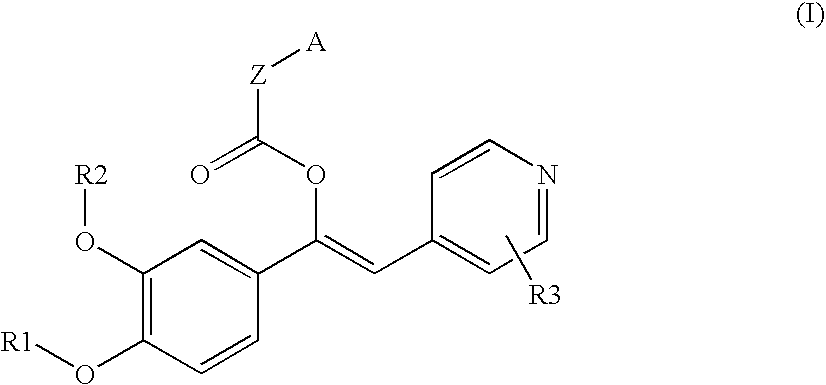Derivatives of 1-phenyl-2-pyridynyl alkylene alcohols as phosphodiesterase inhibitors
a technology of pyridoxine and alkylene alcohol, which is applied in the field of pde4 inhibitors, can solve the problems of limited use of several pde4 inhibitors of the first-generation such as rolipram and piclamilast, and poor selectivity of compounds
- Summary
- Abstract
- Description
- Claims
- Application Information
AI Technical Summary
Benefits of technology
Problems solved by technology
Method used
Image
Examples
example 1
Preparation of 4-difluoromethoxy-3-hydroxybenzaldehyde (2)
[0218]A solution of 3,4-dihydroxybenzaldehyde (16.6 g, 120 mmol) and sodium chlorodifluoroacetate (18.3 g, 120 mmol) in dimethylformamide (150 ml) and water (3 ml) was added with sodium hydroxide (4.8 g, 120 mmol), heated to 120° C. and stirred at this temperature for 2 hrs. The solvent was removed by vacuum distillation and the residue added with aqueous hydrochloric acid (20 ml). The mixture was extracted with diethyl ether (2×50 ml), the combined organic layers were washed with water and brine and the solvent removed under reduced pressure. The crude product was purified by chromatography on silica gel (hexane / ethyl acetate 8:2) to furnish 4-difluoromethoxy-3-hydroxybenzaldehyde as a colourless solid (10 g, 52.8 mmol, 44% yield).
example 2
Preparation of 3-cyclopropylmethoxy-4-difluoromethoxybenzaldehyde (3)
[0219]4-Difluoromethoxy-3-hydroxybenzaldehyde (10 g, 52.8 mmol) was dissolved in tetrahydrofuran (100 ml) added with potassium carbonate (44 g, 105 mmol), cooled to 0° C. and added with a solution of bromomethylcyclopropane (11 ml, 116.6 mmol) in tetrahydrofuran (50 ml). The reaction mixture was heated to reflux under stirring for 7 hrs, then fresh bromomethylcyclopropane (5.5 ml, 58.3 mmol) was added and the heating continued for further 7 hrs. The solvent was removed by vacuum distillation, then the mixture was added with 2 N sodium hydroxide (100 ml) and extracted with dichloromethane (2×100 ml). The combined organic layers were dried over sodium sulphate (5 g) and the solvent removed under reduced pressure to afford 3-cyclopropylmethoxy-4-difluoromethoxybenzaldehyde (12 g, 50 mmol, 97% yield), that was used without further purification.
example 3
Preparation of 3-cyclopropylmethoxy-4-difluoromethoxybenzoic acid (4)
[0220]3-cyclopropylmethoxy-4-difluoromethoxybenzaldehyde (12 g, 50 mmol) and sulfamic acid (7.3 g, 75 mmol) were dissolved in glacial acetic acid (50 ml) and the solution added with a solution of sodium chlorite (8.2 g, 75 mmol) in water (15 ml). The reaction mixture was stirred at room temperature for 1 hr then water (300 ml) was added so obtaining the precipitation of a solid that was filtered and dried at 40° C. under vacuum (12 g, 48 mmol, 97% yield).
PUM
| Property | Measurement | Unit |
|---|---|---|
| temperature | aaaaa | aaaaa |
| temperature | aaaaa | aaaaa |
| temperature | aaaaa | aaaaa |
Abstract
Description
Claims
Application Information
 Login to View More
Login to View More - R&D
- Intellectual Property
- Life Sciences
- Materials
- Tech Scout
- Unparalleled Data Quality
- Higher Quality Content
- 60% Fewer Hallucinations
Browse by: Latest US Patents, China's latest patents, Technical Efficacy Thesaurus, Application Domain, Technology Topic, Popular Technical Reports.
© 2025 PatSnap. All rights reserved.Legal|Privacy policy|Modern Slavery Act Transparency Statement|Sitemap|About US| Contact US: help@patsnap.com



